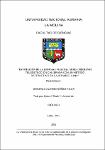Mostrar el registro sencillo del ítem
Estimación de la biomasa vegetal aérea mediante teledetección calibrada con un método destructivo en Cajatambo, Lima
| dc.contributor.advisor | Quinteros Carlos, Diana Zulema | |
| dc.contributor.advisor | Menacho Casimiro, Ernesto Ever | |
| dc.contributor.author | Núñez Vilca, Gonzalo Alonso | |
| dc.date.accessioned | 2022-04-19T02:56:48Z | |
| dc.date.available | 2022-04-19T02:56:48Z | |
| dc.date.issued | 2022 | |
| dc.identifier.uri | https://hdl.handle.net/20.500.12996/5309 | |
| dc.description | Universidad Nacional Agraria La Molina. Facultad de Ciencias. Departamento Académico de Biología | es_PE |
| dc.description.abstract | En los últimos años ha habido una presión del capital natural por parte de la actividad antrópica pudiendo afectar la dinámica de los ecosistemas. Frente a esta problemática se hace necesario crear herramientas capaces de aportar información para la toma de decisiones en la gestión de los ecosistemas. Por lo tanto, dado que el estudio de la biomasa vegetal puede revelar parte de la dinámica ecosistémica y que mediante el uso del sensoramiento remoto y la cartografía, extendidos en el ámbito de la ecología, se tiene la capacidad de correlacionar las respuestas espectrales con parámetros biofísicos; el objetivo del presente trabajo de investigación fue plantear un modelo de estimación de la biomasa vegetal aérea a partir un índice de vegetación. Se usó un método destructivo para calcular el peso seco de la biomasa vegetal aérea muestreada en campo e imágenes satelitales de LANDSAT 8, SENITNEL-2 y SPOT 7 para el cálculo de los índices de vegetación. Posteriormente se calcularon varios modelos de regresión lineal para la estimación y se seleccionó el modelo que presentó el mejor ajuste de estimación y un menor RMSE. El índice EVI fue el elegido para la elaboración del mapa de biomasa estimada al presentar un R2 de 0,43 y un RMSE de 10,006. El modelo es válido para la estimación de biomasa en las coberturas de praderas y matorrales no muy densos. Presentó dificultades para estimar la biomasa de ciertas coberturas vegetales debido a la saturación del índice de vegetación. El aporte del estudio ayudará al desarrollo de herramientas similares aplicados a la realidad nacional, así como destacar el uso de la teledetección como herramienta con varios usos en el campo de la ecología y en la gestión de ecosistemas. | es_PE |
| dc.description.abstract | In recent years it has affected a pressure of natural capital by anthropic activity and may affect the trajectory of ecosystems. Front with this problem, it is necessary to create tools capable of carrying information for decision making. Nature management aims to maintain the properties of a theme ecosystem. The study of plant biomass can reveal part of the dynamics of the ecosystem. The use of the remote sensor and cartography has been extended in the field of ecology, becoming increasingly essential especially for its ability to correlate spectral responses with biophysical parameters. Therefore, the objective of this research work was to propose a model of estimate of aerial plant biomass to a vegetation index. A destructive method was used to calculate the dry weight of aerial plant biomass sampled in the countryside. Use the satellite images of LANDSAT 8, SENITNEL-2 and SPOT 7 to calculate vegetation indices. Later they calculated several linear regression models for the calculated one. The selection criterion was the model that presented a better estimate fit and a lower RMSE. The EVI index was chosen for the elaboration of the estimated biomass map when presenting an R2 of 0,43 and an RMSE of 10,006. The model is valid for the biomass specification for grassland and scrubland not very dense. It presented difficulties in estimating the biomass of certain vegetation cover due to the saturation of the vegetation index. The contribution of the study will help the development of similar tools applied to the national reality. As well as highlighting the use of remote sensing as a tool with various uses in the field of ecology and ecosystem management. | en_US |
| dc.format | application/pdf | en_US |
| dc.language.iso | spa | es_PE |
| dc.publisher | Universidad Nacional Agraria La Molina | es_PE |
| dc.rights | info:eu-repo/semantics/openAccess | en_US |
| dc.rights.uri | https://creativecommons.org/licenses/by-nc-nd/4.0/ | * |
| dc.subject | Vegetación | es_PE |
| dc.subject | Ecosistema | es_PE |
| dc.subject | Sensores | es_PE |
| dc.subject | Satélites | es_PE |
| dc.subject | Datos | es_PE |
| dc.subject | Biomasa | es_PE |
| dc.subject | Índice de vegetación | es_PE |
| dc.subject | Teledetección | es_PE |
| dc.subject | Evaluación | es_PE |
| dc.subject | Perú | es_PE |
| dc.title | Estimación de la biomasa vegetal aérea mediante teledetección calibrada con un método destructivo en Cajatambo, Lima | es_PE |
| dc.type | info:eu-repo/semantics/bachelorThesis | en_US |
| thesis.degree.discipline | Biología | es_PE |
| thesis.degree.grantor | Universidad Nacional Agraria La Molina. Facultad de Ciencias | es_PE |
| thesis.degree.name | Biólogo | es_PE |
| dc.subject.ocde | https://purl.org/pe-repo/ocde/ford#1.06.13 | es_PE |
| renati.author.dni | 76743207 | es_PE |
| dc.publisher.country | PE | es_PE |
| dc.type.version | info:eu-repo/semantics/publishedVersion | en_US |
| renati.advisor.orcid | https://orcid.org/0000-0003-2362-1339 | es_PE |
| renati.advisor.dni | 06089124 | es_PE |
| renati.type | https://purl.org/pe-repo/renati/type#tesis | es_PE |
| renati.level | https://purl.org/pe-repo/renati/level#tituloProfesional | es_PE |
| renati.discipline | 511206 | es_PE |
| renati.juror | Torres Guevara, Juan Jesus | |
| renati.juror | Barrena Arroyo, Víctor Manuel | |
| renati.juror | Tello Cerón, Gladys |
Ficheros en el ítem
Este ítem aparece en la(s) siguiente(s) colección(ones)
-
CIE-BI Tesis [229]



